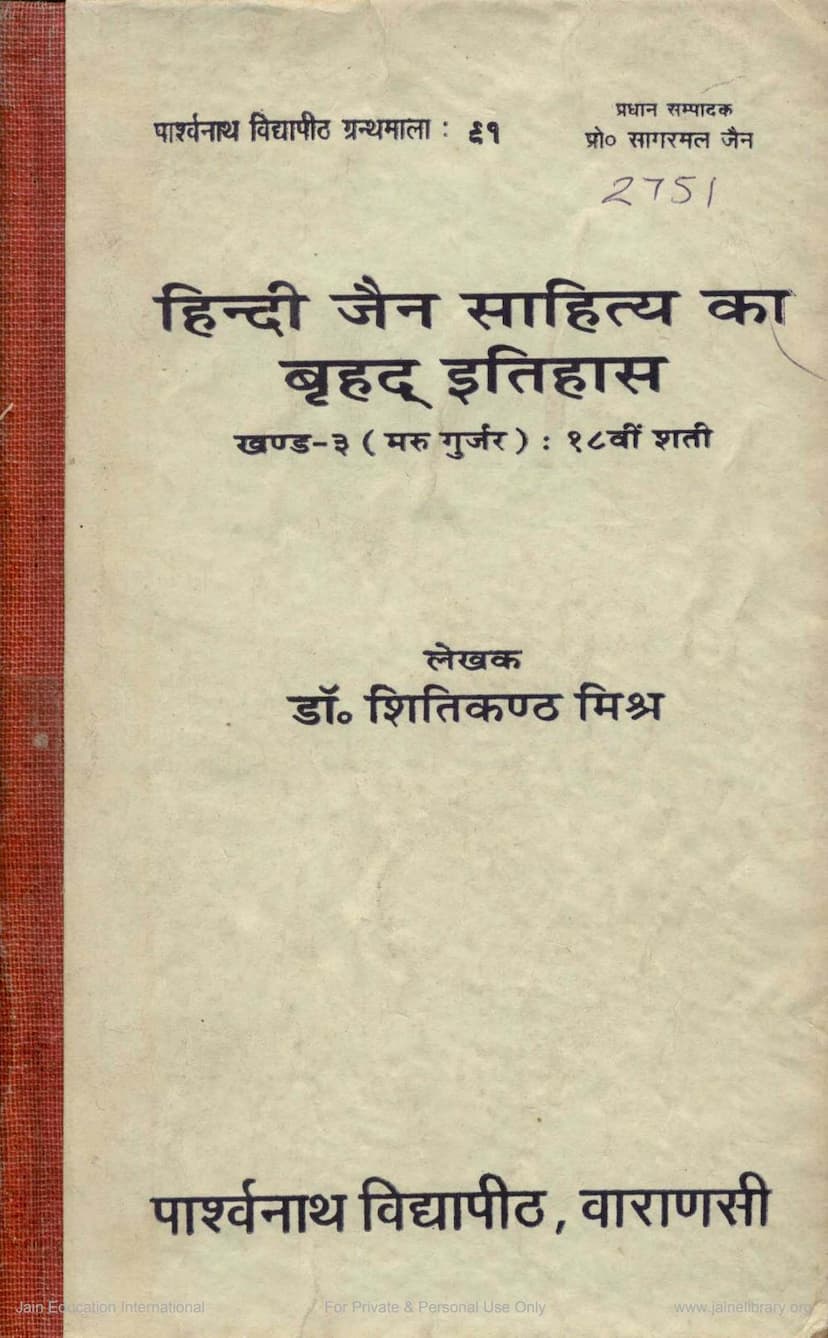Hindi Jain Sahitya Ka Bruhad Itihas Part 3
Added to library: September 1, 2025

Summary
This is a comprehensive summary of "Hindi Jaina Sahitya ka Bruhad Itihas Part 3" by Shitikanth Mishr, focusing on the 18th century (Vikram Samvat 1701-1800), also referred to as "Maru Gurjar".
The book is the third volume in a larger series aiming to document the history of Hindi Jain literature. This particular volume, published by Parsvanath Shodhpith Varanasi, covers the significant literary contributions of Jain authors and poets during the 18th century. The period is characterized by the decline of the Mughal Empire and the rise of regional powers, which influenced the social, political, and religious landscape, and consequently, the literature produced.
Key Aspects Covered:
- Political and Social Background: The book begins by setting the stage with a detailed overview of the political situation in 18th-century India, highlighting the transition from the strong Mughal rule of Shah Jahan and the subsequent decline under Aurangzeb and his successors, leading to the rise of regional powers and the eventual influence of the East India Company. It also delves into the social conditions, describing the feudal system, the stark contrast between the opulent lifestyles of the elite and the struggles of the common populace, and the subordinate position of women in society.
- Religious Landscape: The text examines the religious environment, noting the impact of political and social changes on religious practices. It discusses the interaction of Jainism with other religions and highlights the relative stability and continued influence of Jainism, despite the challenges faced by Hinduism. The role of Jain monks and patrons in influencing rulers and obtaining favorable decrees is also discussed.
- Art and Music: The volume touches upon the state of various arts during this period, including architecture, painting, and music, noting the impact of political instability on patronage and stylistic developments.
- Literary Landscape (Maru Gurjar Hindi Jain Literature):
- Golden Age and Decline: The 17th and 18th centuries are considered a "golden age" for Maru Gurjar Jain literature, with a profusion of works and authors. However, the late 18th century saw a decline in literary activity.
- Key Literary Figures: The book meticulously details the lives and works of numerous Jain poets and writers of the 18th century. It names prominent figures like Meghavijaya, Vinayavijaya, Yashovijaya, Anandaghan, Dharmavardhana, Jinhahersha, and Lakshmivallabha, who contributed significantly in the early part of the century. The author notes that some influential figures from the 17th century continued their creative output into the 18th.
- Influence of Braj Bhasha: The growing prevalence of Braj Bhasha as the dominant literary language outside the Braj region led many Jain poets to adopt it, enriching Maru Gurjar literature with its vocabulary and style.
- Linguistic Features: The language used by these writers is characterized as a blend of traditional Maru Gurjar (an older form of Rajasthani and Gujarati mixed with Hindi), with the increasing influence of Braj Bhasha, and at times, early forms of Khadi Boli. Dialectal variations and regional influences (like Punjabi and Gujarati) are also noted.
- Literary Forms and Themes: The book explores various literary forms prevalent during the period, including Rasa, Chaupai, Prabandh, Katha, Vel, Barahmasa, Stavana, Sanjhay, Doha, Savaiya, and Kavitta. The predominant themes were religious, philosophical, devotional, and moralistic. While devotional and spiritual themes were central, the influence of the Ritikal (period of courtly poetry) is seen in the use of certain poetic conventions and themes, though Jain poets generally steered clear of eroticism and maintained a focus on ethical values.
- Detailed Author Biographies and Works: The bulk of the volume is dedicated to cataloging and describing the works of individual authors. Each entry typically includes the author's name, lineage, guru, birthplace, approximate period of activity, and detailed descriptions of their literary output, often with citations and examples. The authors are listed alphabetically, starting with Achalkirti and going through an extensive list of hundreds of poets and writers.
- Religious and Philosophical Content: The literature often served as a vehicle for propagating Jain philosophy, principles, and practices. Works discussed include those related to the lives of Tirthankaras, Purāṇas, Rāsas explaining Jain tenets, and devotional hymns.
- Contribution to Hindi Literature: The book emphasizes the significant contribution of Jain writers to the enrichment of Hindi literature from its early stages to the modern era.
- Interdisciplinary Approach: The author, Dr. Shitikanth Mishr, has drawn upon the works of prominent scholars like Mohanlal Dalichand Desai and Agarchand Nahata, among others, to compile this extensive history, ensuring a thorough and well-researched account.
In essence, "Hindi Jaina Sahitya ka Bruhad Itihas Part 3 (Maru Gurjar): 18th Century" is a scholarly and exhaustive chronicle of the literary achievements of the Jain community in Hindi during a pivotal century of Indian history. It provides invaluable insights into the poets, their compositions, and the socio-historical context that shaped their creative output, making it a crucial resource for students and scholars of Jain and Indian literature.